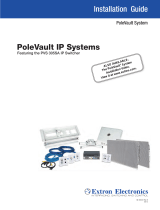
Sixth, the fuse should be changed to the correct amperage rating. For an input power voltage range from 100VAC
to 120VAC, use a 5 amp rated, 250V 5 x 20 mm cartridge type time-delay fuse, which conforms to the interna-
tional fuse classication “T5AL”. For an input power voltage range of from 220VAC to 240VAC, use a 3.15 amp
rated, 250V 5 x 20 mm cartridge type time-delay fuse, which conforms to the international fuse classication
“T3.15AL”.
See Fuse section for detailed instructions on how to remove and install the fuse.
e IEC power cord that is correct for your locale can now be plugged into the IEC receptacle (2), and the Power
switch (4) activated to turn on the powered PVs 18 Sub speaker system.
IEC POWER CORD CONNECTION (2)
is receptacle is for the IEC line cord (normally supplied with the correct pins and wiring for your lo-
cale) that provides AC power to the unit. It is very important that you ensure the PVs 18 Sub has the proper AC
line voltage supplied. You can nd the voltage setting for your PVs 18 Sub by checking the voltage selector switch
on the rear panel of the unit. See above section.
Please read this guide carefully to ensure your personal safety as well as the safety of your equipment.
Never break o the ground pin on any equipment. It is provided for your safety. If the outlet used does
not have a ground pin, a suitable grounding adapter should be used and the third wire should be grounded prop-
erly. To prevent the risk of shock or re hazard, always be sure that the mixer and all other associated equipment
are properly grounded.
FUSE (3)
e unit is AC power line fuse protected from overloads and fault conditions with a slow-blow 5 x 20mm
250V fuse. is fuse is located within the cap of the fuse enclosure just above the ON-OFF switch. If the fuse
fails, THE FUSE MUST BE REPLACED WITH THE SAME TYPE AND VALUE IN ORDER TO AVOID DAM-
AGE TO THE EQUIPMENT AND TO PREVENT VOIDING THE WARRANTY!
e fuse in the PVs 18 Sub can be replaced with a time-delay type 5 x 20 mm size 250V rated fuse.
For 100-120VAC operation, a fuse rated at 5 amps should be used. In the USA, types GDC, GMC, 215, 218, and
477 cartridge-style 5 x 20 mm size fuses with a 5 amp 250V rating can be used. e fuse should conform to the
international fuse classication “T5AL”.
For 220-240VAC operation, a fuse rated at 3.15 amps and 250V should be used, which conforms to the interna-
tional fuse classication “T3.15AL”.
If the unit continues to blow replacement fuses, do not keep replacing them- it should be taken to a qualied
service center for repair.
To replace the fuse, be sure to remove the IEC power cord from the IEC socket (2).
Remove the cap to the fuse enclosure (3) using a at blade screwdriver tip inserted into the fuse cap slot. Push
the cap in and turn the cap CCW and pull the cap out. e blown fuse should come out with the cap. Remove
the
blown fuse and replace it with the proper type per instructions previously supplied. en, once the new fuse has
been put in place, re-insert the fuse enclosure cap, push in and turn the cap CW, and make sure it is fully seated.
Before re-attaching the IEC power cord to the IEC socket, make sure the Power switch is in the OFF position, so
that intermittent contact of the IEC cord while it is being connected will not unduly stress the amplier or the
fuse.
Now re-attach the IEC power cord, and you can then use the Power switch to turn the unit on.
ON-OFF SWITCH (4)
is rocker switch supplies AC power to the PVs 18 Sub when switched to the ON position. e ON position is
with the upper portion of the switch pushed “in” or nearly ush with the rear panel.





















